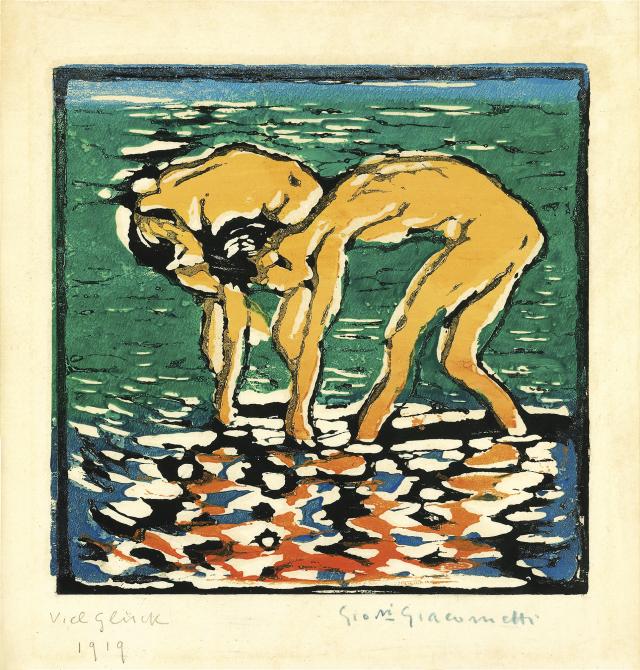On the banks of a lake, two orangey bodies, their contours outlined in black, stand out against an emerald background. The arms and legs of young Alberto and Diego Giacometti undulate in the dark waters, creating elegant eddies and arabesques. Throughout his career Giovanni Giacometti, their father, was intent on depicting the radiance of the sun: “A nude figure in the sun’s play of light is a marvellously beautiful thing. When you have the chance to experience such a joy, it seems to me you ought to put all of your power, all of your knowledge to reproducing that magnificent vision; a painter can dream of no finer occasion to express all of his art of rich colours and forms.”
With Fanciulli nel lago, Giacometti turns to good account the engraved block of wood and areas left bare of colour to signify the bright flashes of light and reveal the ripples in the water. Beneath the force of the summer sun, the unclothed adolescent bodies seem shot through with light and quiver against the cool hues of Lake Sils in a harmonious union of man and nature.
This depiction of youth, vital, alive, ready to strike out on its own, corresponds to the birth of a philosophy that propounded the idea of an élan vital, or life force – a concept theorised by Henri Bergson at the very start of the 20th century. Formally the artist is able to create a dazzling image of sparkling points and transparencies, through a balanced composition whose vertical and horizontal symmetry obeys the principle of parallelism worked out by Ferdinand Hodler. Giacometti focuses above all on the aesthetic and optical phenomenon of light and colour contrasts. Eschewing gradation and modelling, he trims the surfaces with a simplified line and creates colour shadows by combining warm and cool hues.
With Fanciulli nel lago, Giacometti turns to good account the engraved block of wood and areas left bare of colour to signify the bright flashes of light and reveal the ripples in the water. Beneath the force of the summer sun, the unclothed adolescent bodies seem shot through with light and quiver against the cool hues of Lake Sils in a harmonious union of man and nature.
This depiction of youth, vital, alive, ready to strike out on its own, corresponds to the birth of a philosophy that propounded the idea of an élan vital, or life force – a concept theorised by Henri Bergson at the very start of the 20th century. Formally the artist is able to create a dazzling image of sparkling points and transparencies, through a balanced composition whose vertical and horizontal symmetry obeys the principle of parallelism worked out by Ferdinand Hodler. Giacometti focuses above all on the aesthetic and optical phenomenon of light and colour contrasts. Eschewing gradation and modelling, he trims the surfaces with a simplified line and creates colour shadows by combining warm and cool hues.
